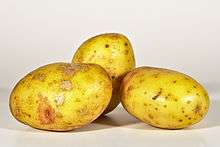King Edward potato
King Edward is a potato variety grown in the UK since 1902, making it one of the oldest varieties still grown commercially.
| King Edward | |
|---|---|
 King Edward | |
| Genus | Solanum |
| Species | Solanum tuberosum |
| Cultivar | 'King Edward' |
| Breeder | John Butler |
| Origin | Scotter, Lincolnshire, Britain 1902 |
Appearance
The King Edward potato is predominantly white-skinned with pink colouration. It is mostly oval in shape, with a floury texture and shallow eyes.[1] The plant is upright and tall with numerous stems and small green leaves. Its flowers are purple with white-tipped petals.
History
In Redcliffe Salaman's book The History and Social Influence of the Potato first published in 1949, it was noted that parentage of King Edward was unknown. It was bred by a gardener in Northumberland who called it 'Fellside Hero' and passed into the hands of a grower in Yorkshire and in turn a potato merchant in Manchester who having no use for it passed it onto John Butler of Scotter in Lincolnshire. He in turn purchased all the seed stocks available and multiplied the variety on 50 acres of land before renaming the variety King Edward on the advice of a potato merchant.[2]
The Coronation of King Edward VII in 1902 coincided with the introduction of this variety of potato and its name is believed to originate as a 'commemoration' of this occasion.[3] It is claimed that the grower wrote to Buckingham Palace seeking permission to name his potato after the monarch and that a reply was received granting royal assent.
It is one of the oldest surviving varieties in Europe.[4]
Cultivating
The King Edward potato is a main crop; in the UK it is traditionally planted in April for harvest in September.[5]
It is suitable to be grown commercially or in the allotment and can even be grown in pots, although smaller ‘first early’ varieties are a more advisable choice for pot cultivation.
To do well, King Edwards require soil that is rich in humus (farm-yard manure/compost) in combination with feeding via a general fertiliser. It is also advisable to ensure plenty of watering during dry periods.
Suggested spacing in a traditional plot is at a depth of 4″ (10 cm), with 12–16″ (30–40 cm) spacing in a row and 28–30″ (70–75 cm) between rows.[6]
It is very resistant to common scab and offers some resistance to potato blight but is susceptible to potato cyst nematode.[3]
King Edwards are not particularly prolific in terms of yield, but many people still grow them for their floury texture and their taste.
Culinary
The King Edward has a variety of culinary uses and is renowned for its light fluffy texture; for this reason it is particularly suitable for roasting, mashed potato or baking, although it is also suitable for chipping, sautéing and steaming. It has been identified by Delia Smith as being the best potato with which to make gnocchi.[7]
References
- Tasmanian Food and Agriculture Dept
- Redcliffe N. Salaman (21 November 1985). The History and Social Influence of the Potato. Cambridge University Press. pp. 169–170. ISBN 978-0-521-31623-1.
- Vegetable Growers Guide
- "R Robinson, 1995". Archived from the original on 2011-05-11.
- Unwins Nurseries
- Dobies Nursery Archived 2008-05-02 at the Wayback Machine
- IN.html "Potatoes make a comeback" Delia Smith Online
Notes
- Raoul Robinson, 1995, Return to Resistance, Breeding Crops to Reduce Pesticide Dependence, ISBN 0-88936-774-4.
- Kriemhild Coneè Ornelas et al., 2000, The Cambridge World History of Food Vol 2,ISBN 978-0-521-40216-3 | ISBN 0-521-40216-6.